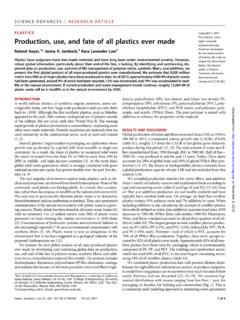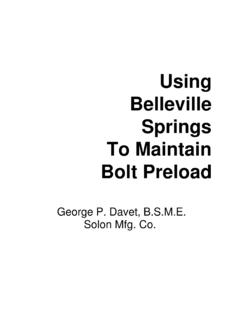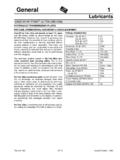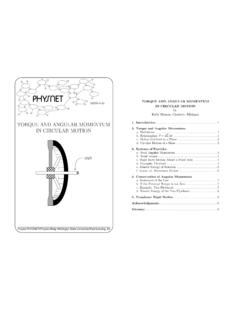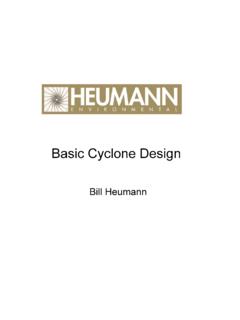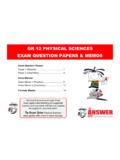Transcription of Boundary lubrication of heterogeneous surfaces the ...
1 SURFACE SCIENCE2016 The Authors, some rights reserved;exclusive licensee American Association forthe Advancement of Science. Distributedunder a Creative Commons AttributionNonCommercial License (CC BY-NC). lubrication of heterogeneous surfacesand the onset of cavitation in frictional contactsDaniele Savio,1* Lars Pastewka,1,2 Peter Gumbsch1,2 surfaces can be slippery or sticky depending on surface chemistry and roughness. We demonstrate in atomistic sim-ulations that regular and random slip patterns on a surface lead to pressure excursions within a lubricated contact thatincrease quadratically with decreasing contact separation. This is captured well by a simple hydrodynamic modelincluding wall slip. We predict with this model that pressurechanges for larger length scales and realistic frictionalconditions can easily reach cavitation thresholds and significantly change the load-bearing capacity of a contact. Cav-itation may therefore be the norm, not the exception, under Boundary lubrication surfaces are heterogeneous .
2 They exhibit natural local variationsin surface chemistry (1 3)androughness(4), and they can be artificiallypatterned to the desired interfacial chemistry (5,6) and topography(7,8). These factors affect wettability (9) and the amount of friction be-tween solids (3) or between wall and fluid during flow (10). Wall frictionis usually quantified by the Navier slip lengthb(11), the fictive distancefromthewallwheretheflowprofilebe comeszerowhenextrapolatedlinearly. Wall slip can be neglected when the channel heighthis muchlarger thanb. This is the case in most macroscopic flow geometrieswhere no slip is assumed to take place at the wall (12). In confined geo-metries, such as those encountered in nanometer-thin lubricants insliding contacts or in Boundary lubrication (13),h~band slip canno longer be ignored. Slip lengths on the order of nanometers and lon-ger (10,14,15) are observed on surfaces with weak interactions and lowcommensurability with the fluid (16 20).
3 Slip reduces friction in lubri-cated devices (21,22) and can be used to control the flow of fluid mix-tures (23). It thus can be exploited in engineering applications (24)bytailoring the surface into slipping and nonslipping domains (25,26).Here, we use molecular dynamics (MD) simulations (see Materialsand Methods) and analytical modelsto show that such local variationsin surface slip can give rise to large pressure excursions within a lubri-cated contact under shearing. We present simple scaling expressionsthat capture the magnitude of the pressure oscillations as a functionof geometry, viscosity, and slip length for regular and random slippatterns. The amplitude of these pressure variations can be orders ofmagnitude larger than the applied pressure and therefore have a pro-found impact on first simulate the simple shearing of a confined lubricant overalternating patches with small andlarge slip lengths. Our MD systemis periodic and has a lengthLof nm and a width of nm in thexandydirections, respectively, with two surfaces separated ath=5nmalongz(see Fig.)
4 1). We use linear pentane (C5H12) as the reference fluidand change the chain length to vary fluid viscosity (see Materials andMethods). The upper surface has no slip, whereas the lower onecontains one slipping and one nonslipping domain of equal lengthl=L/2 oriented transversely to the shearing direction. Shearing is per-formed under conditions representative of a highly loaded lubricatedcontact. An external pressurePext= 250 MPa is applied to the upperwall, which is displaced at a constant velocity ofu2=30 also carry out simulations of smaller homogeneous systemswithout local variations in wall-fluidinteraction to assess slip behavioron homogeneous surfaces and compute the slip length. In this case, thesystem is nm long and its lower surface is either slipping or agreement with many previous studies on this type of geometry(16,18), we obtain linear (Couette) velocity profilesu(z)acrossthefilmthicknessz(red points in Fig.
5 2, A and B). Slip causes partial plug flow(Fig. 2B), which increases the flow rate relative to the configuration withtwo nonslipping walls (Fig. 2A).The flow profile in the heterogeneous system is not linear despite thesimple shear geometry. The blue points in Fig. 2 (A and B) show that thefluidindeedsticksandslipsintherespect ive domains, but the velocityprofile curves toward higher velocity in the sticking region and towardlower velocity in the slipping region. Because mass is conserved, theglobal flow rate through the channel needs to be constant. Slip increasesmass transport near the interface,which must be compensated by thelower mass transport in the bulk of the fluid flowing over the slippingregion and the enhanced mass transport in the fluid flowing over thesticking test whether Navier-type slipboundary conditions apply to theheterogeneous system, we quantify the local slip length for each of the192 bins from the local velocity profiles as shown in Fig.
6 2 (A and B).The local slip length is given byb(x)=u(x,z)/( u(x,z)/ z)|z=0,whereuisthe fluid velocity andzis the position within the channel. Localvariations in slip are shown in Fig. 2C and are large. This can beattributed to the large error introduced by extrapolating the velocityprofile. Nevertheless, we find an approximately constant value on eachdomain: in the nonslip region, we findb= 0, whereas on the slippingside,b , consistent with calculations from the reference systemwith homogeneous walls (shown by the red line in Fig. 2C).Slip is hence a local property. This is because the geometrical expres-sion for the slip length stems from the fluid viscosityhand the tangentialmomentum transfer at the wall-fluid interface (11,27), which are localproperties independent of the neighboring domains. The transitionzone from no slip to slip is located at the domain boundaries within theslipping domain (Fig. 2C). Its length is ~ 4 nm, which is approximately1 Institute for Applied Materials, Karlsruhe Institute of Technology, Engelbert-Arnold-Stra e 4,76131 Karlsruhe, Institute for Mechanics of Materials IWM, MicroTribologyCentermTC, W hlerstra e 11, 79108 Freiburg, Germany.
7 *Corresponding author. E-mail: ARTICLES avio, Pastewka, Gumbsch Sci. Adv. 2016;2:e1501585 25 March 20161of5 on August 31, 2018 from 10 times the chain length of pentane. It does not change significantly forother shortn-alkanes or for other domain lengthslused in this workand may thus be considered negligible compared to typical pattern sizes(on the order of micrometers) that can be realized velocity profiles shown in Fig. 2 (A and B) are fully captured by asimple hydrodynamic model that assumes a constant slip length on each equation for fluid flow along the shearing (x) direction. Because theestimated Reynolds number for the chosen system Re = is low and thethin-film approximationh/l 1 applies, the expression can be simplifiedfor laminar flow and negligible inertia effects (12). In steady state, this gives P x z u z 1 where we have normalized the fluid velocity by the driving velocityu2, u u=u2;alllengthsbyl, x x=l;andallheightsbyh, z z= leads to a normalized pressure P P=P0, whereP0=lt0/handt0=hu2/his the shear stress necessary to drive the Couette flow of aNewtonian fluid of shear viscosityh.
8 Integrating Eq. (1) twice in thezdirection with a no-slip condition and velocityu2on the upper wall anda Navier slip Boundary with slip length b b=hon the lower surfacegives the velocity profile u x; z z b x 1 b x 12 z2 z b x 1 b x P x 2 The first summand in Eq. (2) is of linear order and hence Couette-like,whereas the second summand is of quadratic order and pressure gradient P= xin Eq. (2), which is the origin of thePoiseuille contribution, is given bythe well-known Reynolds equation,obtained from combining Eqs. (1) and (2) with the continuity equation (12) x1 4 b x 1 b x P x 61 b x 0 3 Equation (3) accounts for slip on the lower surface and is valid for in-compressible, isoviscous fluids under isothermal and steady-stateconditions. It can be solved directlyby integration (see discussion S1).For the geometry used in our MD calculations, b x 0for0< x<1and b x bsfor 1 x<2. Accounting for the periodicity of thesystem along the shearing direction P x 0 P x 2 ,thepressuregradient isd Pd x 6k=5if0 x<16k=5if1 x<2 4 withk 5 bs= 2 5 bs.
9 This factor, valid for two grains of the samelengthl,variesbetweenk= 0 for bs 0 (homogeneous limit) andk=1for bs .The black solid lines in Figs. 2 and 3 show that this simple hydro-dynamic model perfectly reproduces MD results despite the severe con-finement of the fluid. The curved velocity profiles in Fig. 2 (A and B) arecaptured well by Eq. (2), confirming that fluid flow even down to achannel height of a few nanometers for molecules that are 1nminsize can be described by continuum hydrodynamics (28). The pressurealong the channel is obtained trivially by integrating Eq. (4) once. Thisgives a pressure drop ofdP= 6khu2l/(5h2) 1. MD simulation fluid is confined between two surfaces . There is no slip on the top surface and the bottom surface is patterned intoslipping and sticking domainSlipping domainSlip lengthABCFig. 2. Profiles of dimensionless velocity u u=u2across the normal-ized film thickness z z=hfor the heterogeneous system.
10 (AtoC)Sticking domain (A), slipping domain (B), and corresponding normalized sliplength b b=h(C) along the shearing direction x x= ARTICLES avio, Pastewka, Gumbsch Sci. Adv. 2016;2:e1501585 25 March 20162of5 on August 31, 2018 from Figure 3 shows that the total pressure P x indeed drops linearly on thesticking domain, followed by an increase in the slipping region. Pressureexcursions become larger with the applied shear rate through eitherhigher wall velocityu2or smaller film thicknessh, with the viscosityhof the fluid, and with the system lengthL. For example, longern-alkane chains lead to higher fluid viscosityhand factork, which giveslarger pressure the length of the system shows thatdP/dxis independenton the domain length; thus, the overall pressure variations along theshearing directions scale linearly with the periodicity to vanishing pressure excursions whenLis very small, that is,when it is comparable to the chain length of the fluid molecules.





